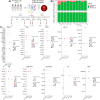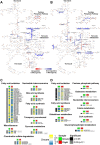Aging and putative frailty biomarkers are altered by spaceflight
- PMID: 38862573
- PMCID: PMC11166946
- DOI: 10.1038/s41598-024-57948-5
Aging and putative frailty biomarkers are altered by spaceflight
Abstract
Human space exploration poses inherent risks to astronauts' health, leading to molecular changes that can significantly impact their well-being. These alterations encompass genomic instability, mitochondrial dysfunction, increased inflammation, homeostatic dysregulation, and various epigenomic changes. Remarkably, these changes bear similarities to those observed during the aging process on Earth. However, our understanding of the connection between these molecular shifts and disease development in space remains limited. Frailty syndrome, a clinical syndrome associated with biological aging, has not been comprehensively investigated during spaceflight. To bridge this knowledge gap, we leveraged murine data obtained from NASA's GeneLab, along with astronaut data gathered from the JAXA and Inspiration4 missions. Our objective was to assess the presence of biological markers and pathways related to frailty, aging, and sarcopenia within the spaceflight context. Through our analysis, we identified notable changes in gene expression patterns that may be indicative of the development of a frailty-like condition during space missions. These findings suggest that the parallels between spaceflight and the aging process may extend to encompass frailty as well. Consequently, further investigations exploring the utility of a frailty index in monitoring astronaut health appear to be warranted.
© 2024. The Author(s).
Conflict of interest statement
The authors declare no competing interests.
Figures








Similar articles
-
Neurosurgery and spinal adaptations in spaceflight: A literature review.Clin Neurol Neurosurg. 2021 Aug;207:106755. doi: 10.1016/j.clineuro.2021.106755. Epub 2021 Jun 8. Clin Neurol Neurosurg. 2021. PMID: 34126454 Review.
-
Spaceflight-Associated Brain White Matter Microstructural Changes and Intracranial Fluid Redistribution.JAMA Neurol. 2019 Apr 1;76(4):412-419. doi: 10.1001/jamaneurol.2018.4882. JAMA Neurol. 2019. PMID: 30673793 Free PMC article.
-
Transcriptomics analysis reveals molecular alterations underpinning spaceflight dermatology.Commun Med (Lond). 2024 Jun 11;4(1):106. doi: 10.1038/s43856-024-00532-9. Commun Med (Lond). 2024. PMID: 38862781 Free PMC article.
-
Leveraging Spaceflight to Advance Cardiovascular Research on Earth.Circ Res. 2022 Mar 18;130(6):942-957. doi: 10.1161/CIRCRESAHA.121.319843. Epub 2022 Mar 17. Circ Res. 2022. PMID: 35298305 Free PMC article. Review.
-
Association of Long-Duration Spaceflight With Anterior and Posterior Ocular Structure Changes in Astronauts and Their Recovery.JAMA Ophthalmol. 2020 May 1;138(5):553-559. doi: 10.1001/jamaophthalmol.2020.0673. JAMA Ophthalmol. 2020. PMID: 32239198 Free PMC article.
Cited by
-
NASA open science data repository: open science for life in space.Nucleic Acids Res. 2025 Jan 6;53(D1):D1697-D1710. doi: 10.1093/nar/gkae1116. Nucleic Acids Res. 2025. PMID: 39558178 Free PMC article.
-
Long non-coding RNAs Kcnq1ot1 and Lncpint are involved in skeletal muscle atrophy induced by the space exposome.J Physiol. 2025 Jul;603(14):3973-3986. doi: 10.1113/JP288987. Epub 2025 Jun 29. J Physiol. 2025. PMID: 40581981 Free PMC article.
-
Editorial for Special Issue "Cellular Senescence: Recent Cellular Advances and Discoveries".Biomedicines. 2024 Dec 9;12(12):2796. doi: 10.3390/biomedicines12122796. Biomedicines. 2024. PMID: 39767702 Free PMC article.
References
MeSH terms
Substances
Grants and funding
LinkOut - more resources
Full Text Sources
Medical
Miscellaneous

